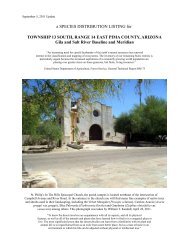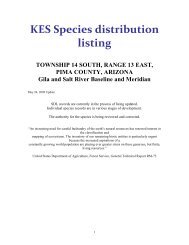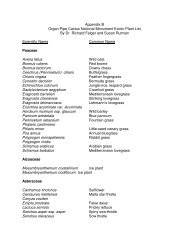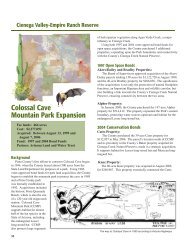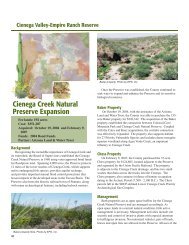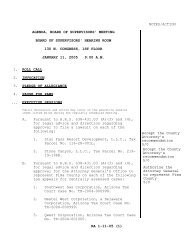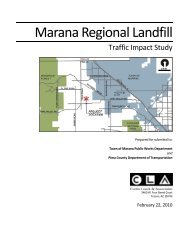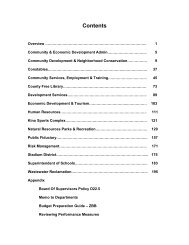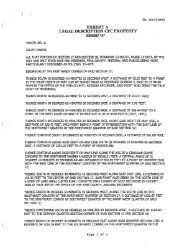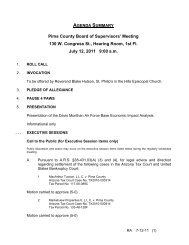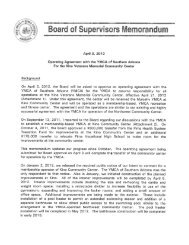Le Jardin de Mère Nature dans une Petite Planète - Pima County
Le Jardin de Mère Nature dans une Petite Planète - Pima County
Le Jardin de Mère Nature dans une Petite Planète - Pima County
Create successful ePaper yourself
Turn your PDF publications into a flip-book with our unique Google optimized e-Paper software.
slopes; alluvial fans; gravelly and sandy bajadas; rocky outcrops; sand d<strong>une</strong>s; plains; gravelly and sandy<br />
flats; basins; rocky and sandy valley floors; along rocky and sandy roadsi<strong>de</strong>s; within arroyos; clayey<br />
bottoms of arroyos; draws; gullies; within gravelly and sandy washes; swales; banks of ravines; terraces;<br />
floodplains; lowlands, and disturbed areas growing in dry rocky <strong>de</strong>sert pavement; boul<strong>de</strong>ry, rocky, rockygravelly,<br />
shaley, gravelly and sandy ground; sandy loam ground; silty clay and clay ground, and sandy<br />
silty ground, occurring from 1,800 to 8,800 feet, in elevation in the woodland, grassland and <strong>de</strong>sertscrub<br />
ecological formations. NOTES: This plant may be an attractive component of a restored native habitat.<br />
Bahia absinthifolia is native to southwest-central and southern North America. *5, 6, 16, 28 (color<br />
photograph), 43 (111309), 46 (Page 925), 63 (111309 - color presentation), 77 (color photograph #16), 85<br />
(111309 - color presentation), 115 (color presentation)*<br />
Brickellia bacchari<strong>de</strong>a A. Gray: Resinleaf Brickellbush<br />
COMMON NAMES: Baccharis-leaf Brickellia, Baccharisleaf Brickellbush, Brickell-bush,<br />
Brickellbush, Resinleaf Brickellbush. DESCRIPTION: Terrestrial perennial subshrub or shrub (to 3 feet<br />
in height); flowering generally takes place between September and November. HABITAT: Within the<br />
range of this species it has been reported from crevices in boul<strong>de</strong>rs and rocky slopes growing in dry<br />
boul<strong>de</strong>ry and rocky ground, occurring from 500 to 5,500 feet in elevation in the grassland and <strong>de</strong>sertscrub<br />
ecological formations. NOTE: Brickellia bacchari<strong>de</strong>a is native to southwest-central and southern North<br />
America. *5, 6, 13, 15, 43 (063010), 46 (Page 849), 48 (genus), 58, 63 (063010), 77, 85 (063010 - color<br />
presentation of dried material, unable to access to species information), 138*<br />
Brickellia coulteri A. Gray: Coulter’s Brickellbush<br />
SYNONYMY: Brickellia coulteri A. Gray var. coulteri. COMMON NAMES: Brickellbush,<br />
Coulter’s Brickellbush. DESCRIPTION: Terrestrial perennial subshrub or shrub (1 to 5 feet in height);<br />
the florets (disc flowers only) may be cream, cream-maroon-purple, cream-purple, cream-white, creamyellow,<br />
green, greenish-yellow, purplish, purplish-brown, white, yellow or yellow-green; flowering<br />
generally takes place between late January and mid-November (additional records: two for early<br />
December and two for mid-December). HABITAT: Within the range of this species it has been reported<br />
from boul<strong>de</strong>ry mountains; rocky and gravelly-sandy mountainsi<strong>de</strong>s; cliff faces; rocky and rocky-sandy<br />
canyons; rocky canyon bottoms; rocky talus slopes; bases of cliffs; crevices in rocks; rock ledges; rocky<br />
ridges; clearings in woodlands; foothills; rocky hills; rocky hillsi<strong>de</strong>s; rocky slopes; rocky outcrops;<br />
amongst boul<strong>de</strong>rs and rocks; flats; basins; valley floors; arroyos; rocky bottoms of arroyos; rocky draws;<br />
rocky walls of ravines; springs; along streams; along boul<strong>de</strong>ry and boul<strong>de</strong>ry-rocky streambeds; along<br />
rivers; along and in rocky, rocky-gravelly, gravelly, gravelly-loamy and sandy washes; rocky and pebbly<br />
drainages; boul<strong>de</strong>ry and rocky drainage ways; around waterholes; along sandy and silty-loamy banks of<br />
washes and drainages; edges of washes; floodplains, and rocky and gravelly-sandy riparian areas growing<br />
in dry boul<strong>de</strong>ry, rocky, rocky-gravelly, rocky-sandy, gravelly, gravelly-sandy, pebbly and sandy ground;<br />
gravelly loam, sandy loam, silty loam and loam ground, and rocky clay ground, occurring from sea level<br />
to 4,500 feet in elevation in the woodland, grassland, <strong>de</strong>sertscrub and wetland ecological formations.<br />
NOTES: This plant may be an attractive component of a restored native habitat. The flowers are reported<br />
to be fragrant. Brickellia coulteri is native to southwest-central and southern North America. *5, 6, 13,<br />
15, 16, 28 (color picture), 43 (111409), 46 (Page 849), 48 (genus), 58, 63 (111409), 77, 85 (111409 - color<br />
presentation), 115 (color presentation), 138*<br />
Brickellia coulteri var. coulteri (see Brickellia coulteri)<br />
Chaenactis carphoclinia A. Gray (var. carphoclinia is the variety reported as occurring in Arizona):<br />
Pebble Pincushion<br />
SYNONYMY: (for C.c. var. carphoclinia: Chaenactis carphoclinia A. Gray var. attenuata (A.<br />
Gray) M.E. Jones). COMMON NAMES: Broadleaved Chaenactis, False Yarrow, Pebble False-yarrow,<br />
Pebble Pincushion, Pincushion Flower. DESCRIPTION: Terrestrial annual forb/herb (2 to below 28




